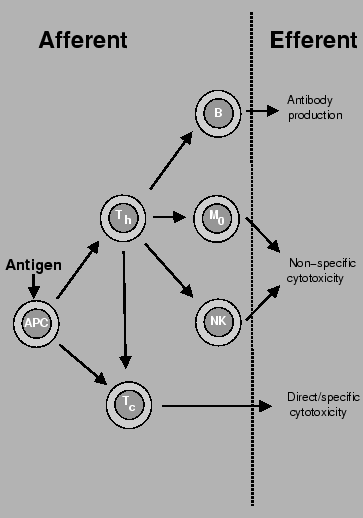



Next: Antigen presenting cells
Up: Immune response to transplantation
Previous: Minor Histocompatibility Complex
Index
Table 1:
Cells commonly found in the
blood. Other cells that are seen include all types of immature progeinitor
cells and endothelial and endomyocardial progenitors
| Red blood cells |
| Platlets |
| White blood cells |
| |
Granulocytes |
| |
|
Polymorphonuclear cells |
| |
|
Eosinophils |
| |
|
Basophils |
| |
Agranulocytes |
| |
|
Lymphocytes |
| |
|
Monocytes |
The cells of the blood consist of red blood cells, white blood cells and
platelets, see table 1. The white blood cells may be
divided into polymorphonuclear cells, lymphocytes, monocytes, basophils and
eosinophils. Unlike the red blood cells and the platelets the white blood cells
frequently exit the circulation. The polymorphonuclear cells will go to a
site of injury and try to kill anything that it does not like. Lymphocytes
play a role in conducting the orchestra of the immune system. Monocytes will
change into macrophages when suitably stimulated. The lymphocytes are
broadly divided into B cells and T cells. The B cell produces antibodies and
the T cells may be cytotoxic, helpers or suppressors.
Figure 4:
Schematic representation
of the afferent and efferent arms of the immune response. APC: antigen
presneting cell, T : T helper cell (CD4+), T
: T helper cell (CD4+), T : Cytotoxic T cell
(CD8+), B: B cell, M
: Cytotoxic T cell
(CD8+), B: B cell, M : Monocyte, NK: Natural Killer cell. The antigen
is presented by the antigen presenting cell. Certain T
: Monocyte, NK: Natural Killer cell. The antigen
is presented by the antigen presenting cell. Certain T and T
and T cells
will bind with the antigen presented with the antigen bound to self MHC
protein on the surface of the antigen presenting cell. This stimulates the
T cells to mount a response to the antigen via antibondy production,
non-specific cytotoxicity and specific/direct cytotoxicity.
cells
will bind with the antigen presented with the antigen bound to self MHC
protein on the surface of the antigen presenting cell. This stimulates the
T cells to mount a response to the antigen via antibondy production,
non-specific cytotoxicity and specific/direct cytotoxicity.
 |
In essence the function of the immune system is to protect the self from
non-self. It is necessary to have a system in place to fight off pathogens
such as viri, bacteria and parasites. It would also be nice if this system
could play a role in killing cancer cells. At the same time it is not a good
idea for the immune system to damage the self.
The function of the immune system may be conceptualised into afferent and
efferent arms, see figure 4. The afferent arm consists of;
- Information gathering and presentation
- which is done primarly by the
antigen presenting cells
- Computation and recruitment
- which is done mainly by helper T cells
both locally and remotely
The efferent arm of the immune response consists of;
- Antibody mediated response
- B lymphocytes produce antibody which binds
with antigen, activates complement etc.
- Non specific cell mediated response
- is performed by macrophages and
natural killer cells in response to stimulation by helper T cells
- Specific cell mediated response
- is mediated by specific cytotoxic T
cells
Subsections




Next: Antigen presenting cells
Up: Immune response to transplantation
Previous: Minor Histocompatibility Complex
Index
Adrian P. Ireland
2004-02-17